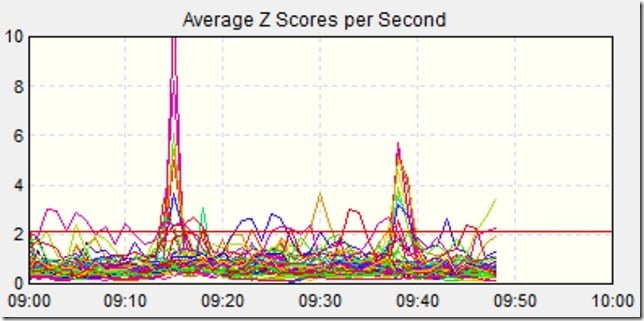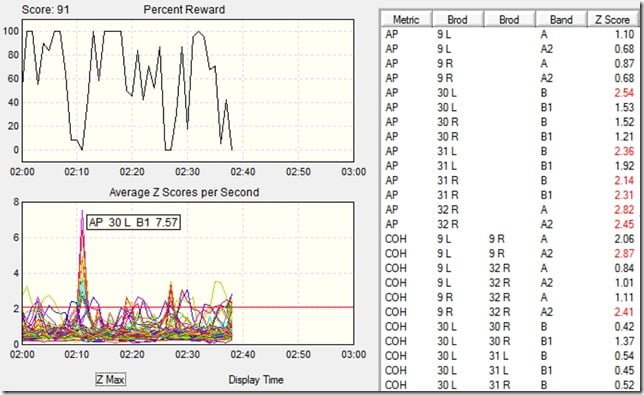The same week we began stimulation of my Wernicke’s area, we saw beta spikes for the first time during my LORETA neurofeedback session. It began right with the first screen. And it wasn’t just a spike of five or six standard deviations from the norm, it was an off-the-chart spike.

My trainer spoke to Andrea Reid-Chung, Clinical Coordinator of the ADD Centre, and Dr. Michael Thompson to see what’s up with that while I continued on training for another five-minute screen. Andrea came to look at the results and to discuss my experience of it. The training on August 8th felt different to me because the display flickered like crazy, with the display unable to make up its mind whether to fill the screen or disappear. Well, okay, it was my brain unable to decide what to do. Although it’s not clear in the above picture, we began to see a trend. First, the usual kind of spike in coherence in the alpha band, then the picture would shrink right down to nothing, then right after that the beta spike, and right after that the picture would fill the screen. The image below shows this. The Percent Reward shows the picture size and below it the corresponding average Z scores of the brainwave amplitudes and coherences. You can see the relatively small coherence spike, followed by the beta spike (which is labelled), and how the picture correspondingly disappears and reappears. The numbers on the right reflect another one happening (Percent Reward is about 0 at the end of the line). All the Z scores in red are the amplitudes and coherences above 2.1 standard deviations above the norm in Brodmann areas 30L (beta), 31L (beta), 31R (beta and beta 1), 32R (alpha and alpha 2), 9L and 9R coherence in alpha 2, and 9R and 32R in alpha 2. It seems to be usually beta 1 in Brodmann areas 30L or 30R that spikes off the chart, that is to ten standard deviations from the norm or higher.

So what does this mean? And was it related to the Wernicke’s area stimulation?
The theory was that, although I’m sensitive, it couldn’t be the stimulation since the effect of tDCS in the first few sessions lasts minutes or hours not days. Only when done over time, does the effect last days. I’d had exactly one stimulation. I still think there must be some connection because those beta spikes didn’t show until the same week I began tDCS at Wernicke’s area. Could it really be just a coincidence?
The beta spikes appeared again last week and again this week, although that initial flickering I experience has not happened since. The spikes are also reducing in frequency and in height.
We’ve decided that the spikes mean my brain is resetting. Basically, it stops trying to keep under that 2.1 standard deviation threshold and goes off to sit in the default network for a second, kind of like Windows closing all programs and rebooting. The beta brainwave spikes, and it’s way off the norm for the default network. Beta waves are the waves of an active brain. So it’s a very high, sudden, short burst of brain activity. The beta spike’s location apparently reflects the connection between emotion and memory. So let’s see if I can think this through: my brain goes into default network, it then emits a beta spike in Brodmann area 30 left or right, and immediately after that, the picture reappears in full. It’s like my brain needs to reset in order to establish a connection between emotion and memory, which connection has been short-circuited for a long, long time since my brain injury and, perhaps relevant to this particular brain event, bad things that happened after my injury that had not elicited emotions for longer than a day or two and so memories were laid down sans emotion. Then biofeedback in 2005 began to re-awaken those emotions, such that they overwhelmed me. We dialled things back, but although my emotional centre slowly began to inch towards normal functioning, I still laid down memories of bad events without corresponding emotions or, at best, emotions that lasted a short while and then went off on holiday again. I knew what emotions I should feel, but I just didn’t. Also, when I did have emotional reactions, they were hours or days after the fact. Perhaps these beta spikes are the brain starting to connect memory A to emotion A and memory B to emotion B as current bad events cascade old post-brain injury memories into my consciousness that then connect to how things used to be before my injury that then starts the grieving process and also cycles back to present day and the memories in between. And with the connection between emotion and memory being suddenly active, my brain coherences between Brodmann areas 9 and 32 or 9L and 9R, which I think are related to my working memory network, get going again. And we have a picture to watch again.
Anyway, that’s as near as I can figure out. The thing is I don’t actually feel all that stuff during that brief beta spike; it’s what’s happening now these past three weeks or so.
We’re bouncing between Frozen Planet and Born to be Wild these weeks. Since it was hot and humid and melty today, I was all for watching the Winter part of BBC’s Frozen Planet. Unfortunately, it ended with a grisly scene. So my brain was having a mighty battle with itself in the last minute of the last screen: one side wanted to keep the picture up, my mind was all for shutting it down and not watching the bison kill the wolf. As a result, I think my last score is lower than it otherwise would’ve been.
We dropped the threshold to 1.9 standard deviations above the norm, which theoretically made it harder. I certainly felt like doing a face plant and having an instant snooze after the second screen. But after the third, I began to feel bright and refreshed and alert. An hour or so after the session, I began to feel dizzy. My new theory is that dizzy isn’t a sign of improvement but a sign of change, kind of like when your skin is scratched. It’s painful and itchy at first and after when it begins to heal too. It’s the context that tells you whether it’s injury or improvement. So in this case, it’s improvement. My scores were all in the 180s, except during the screen when we switched off the sub-titles (I am reading subtitles for the first three screens and not during the last three; last week I read for the first four screens). A pretty consistent performance.




